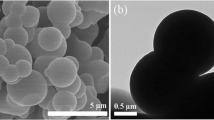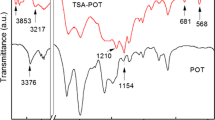Abstract
Imidazolium-based poly(ionic liquid) (PIL) microspheres of poly(1-butyl-3-vinylimidazolium tetrafluoroborate) (P[C4VIm][BF4]) were synthesized through a dispersion polymerization process, which was confirmed by 1H NMR, FT-IR and SEM. Rheological measurement at different electric field strengths indicated that the P[C4VIm][BF4] microspheres in dimethyl silicone oil (15 wt%) showed typical electrorheological (ER) performances including steady flow curves over the entire shear rate range. The ER fluid performed like a Newtonian fluid with very low shear viscosity at zero electric field, which implied the good affinity of the PIL particles with silicone oil. From the ER result, it is worth remarking that the good ER activity of the P[C4VIm][BF4]-based ER fluid is due to the high-density ion parts which can induce strong interfacial polarization.











Similar content being viewed by others
References
Sheng P, Wen W (2012) Electrorheological fluids: mechanisms, dynamics, and microfluidics applications. Annu Rev Fluid Mech 44:143–174
Yin J, Zhao X, Xia X, Xiang L, Qiao Y (2008) Electrorheological fluids based on nano-fibrous polyaniline. Polymer 49:4413–4419
Jang DS, Zhang WL, Choi HJ (2014) Polypyrrole-wrapped halloysite nanocomposite and its rheological response under electric fields. J Mater Sci 49:7309–7316. doi:10.1007/s10853-014-8443-5
Madeja J, Kesy Z, Kesy A (2011) Application of electrorheological fluid in a hydrodynamic clutch. Smart Mater Struct 20:105005. doi:10.1088/0964-1726/20/10/105005
Nguyen QH, Choi SB, Park YG (2012) An analytical approach to optimally design of electrorheological fluid damper for vehicle suspension system. Meccanica 47:1633–1647
Tsuda K, Hirose Y, Ogura H, Otsubo Y (2010) Motion control of pattern electrode by electrorheological fluids. Colloids Surf A Physicochem Eng Asp 360:57–62
Zhang MY, Wang LM, Wang X, Wu JB, Li JX, Gong XQ, Qin JH, Li WH, Wen WJ (2011) Microdroplet-based universal logic gates by electrorheological fluid. Soft Matter 7:7493–7497
Bilyk VA, Korobko EV (2015) Research of the influence of dissipative heating on the performance characteristics of electrorheological shock absorbers. J Intell Mater Syst Struct 26:1906–1912
Song XR, Hu AQ, Tan NY, Ma D, Lin YB (2011) Influence of amphiprotic groups on the electrorheological behavior of polymers. Mater Chem Phys 126:369–374
McIntyre EC, Yang H, Green PF (2012) Electrorheology of polystyrene filler/polyhedral silsesquioxane suspensions. ACS Appl Mater Interf 4:2148–2153
Jiang J, Tian Y, Meng Y (2011) Structure parameter of electrorheological fluids in shear flow. Langmuir 27:5814–5823
Ko YG, Lee HJ, Chun YJ, Choi US, Yoo KP (2013) Positive and negative electrorheological response of alginate salts dispersed suspensions under electric field. ACS Appl Mater Interf 5:1122–1130
Tian Y, Meng Y, Wen S (2001) Electrorheology of a zeolite/silicone oil suspension under dc fields. J Appl Phys 90:493–496
Yin JB, Zhao XP (2002) Preparation and electrorheological activity of mesoporous rare-earth-doped TiO2. Chem Mater 14:4633–4640
Choi HJ, Jhon MS (2009) Electrorheology of polymers and nanocomposites. Soft Matter 5:1562–1567
Yilmaz H, Zengin H, Unal HI (2012) Synthesis and electrorheological properties of polyaniline/silicon dioxide composites. J Mater Sci 47:5276–5286. doi:10.1007/s10853-012-6413-3
Liu YD, Choi HJ (2012) Electrorheological fluids: smart soft matter and characteristics. Soft Matter 8:11961–11978
Lee S, Lee J, Hwang S, Yun J, Jang J (2015) Enhanced electro-responsive performance of double shell SiO2/TiO2 hollow nanoparticles. ACS Nano 9:4939–4949
Zhang WL, Choi HJ (2014) Graphene oxide based smart fluids. Soft Matter 10:6601–6608
Yin J, Chang R, Shui Y, Zhao X (2013) Preparation and enhanced electro-responsive characteristic of reduced graphene oxide/polypyrrole composite sheet suspensions. Soft Matter 9:7468–7478
Hiamtup P, Sirivat A, Jamieson AM (2010) Strain-hardening in the oscillatory shear deformation of a dedoped polyaniline electrorheological fluid. J Mater Sci 45:1972–1976. doi:10.1007/s10853-009-4189-x
Sedlačík M, Mrlík M, Pavlínek V, Sáha P, Quadrat O (2012) Electrorheological properties of suspensions of hollow globular titanium oxide/polypyrrole particles. Colloid Polym Sci 290:41–48
Schwarz G, Maisch S, Ullrich S, Waenhofer J, Kurth DG (2013) Electrorheological fluids based on metallo-supramolecular polyelectrolyte-silicate composites. ACS Appl Mater Interf 5:4031–4034
Cho MS, Kim JW, Choi HJ (2005) Polyaniline and its modification for electroresponsive material under applied electric fields. Polym Adv Technol 16:352–356
Gordon CM, Holbrey JD, Kennedy AR, Seddon KR (1998) Ionic liquid crystals: hexafluorophosphate salts. J Mater Chem 12:2627–2636
Marwani HM (2010) Spectroscopic evaluation of chiral and achiral fluorescent ionic liquids. Cent Eur J Chem 8:946–952
David M (2011) Polymeric ionic liquids: broadening the properties and applications of polyelectrolytes. Prog Polym Sci 36:1629–1648
Yuan J, Mecerreyes D, Antonietti M (2013) Poly(ionic liquid)s: an update. Prog Polym Sci 38:1009–1036
Lee S, Cummins MD, Willing GA, Firestone MA (2009) Conductivity of ionic liquid-derived polymers with internal gold nanoparticle conduits. J Mater Chem 19:8092–8101
Dong YZ, Yin JB, Zhao XP (2014) Microwave-synthesized poly(ionic liquid) particles: a new material with high electrorheological activity. J Mater Chem A 2:9812–9819
Dong YZ, Yin JB, Zhao XP (2016) Microwave-assisted synthesis and high-performance anhydrous electrorheological characteristic of monodisperse poly(ionic liquid) particles with different size of cation/anion parts. Polymer 97:408–417
Varma RS, Namboodiri VV (2001) An expeditious solvent-free route to ionic liquids using microwaves. Chem Commun 32:643–644
Namboodiri VV, Varma RS (2002) An improved preparation of 1,3-dialkylimidazolium tetrafluoroborate ionic liquids using microwaves. Tetrahedron Lett 43:5381–5383
Tokuda M, Minami H, Mizuta Y, Yamagami T (2012) Preparation of micron-sized monodisperse poly(ionic liquid) particles. Macromol Rapid Commun 33:1130–1134
Wang D, Dimonie VL, Sudol ED (2002) Effect of PVP in dispersion and seeded dispersion polymerizations. J Appl Polym Sci 84:2721–2732
Liu YD, Quan XM, Lee BM, Kim IG, Choi HJ (2014) Fabrication of ammonium persulfate coated silica microsphere via chemical grafting and its electrorheology. J Mater Sci 49:2618–2623. doi:10.1007/s10853-013-7961-x
Yin JB, Zhao XP, Xiang LQ (2009) Enhanced electrorheology of suspensions containing sea-urchin-like hierarchical Cr-doped titania particles. Soft Mater 5:4687–4697
Cho MS, Choi HJ, Jhon MS (2005) Shear stress analysis of a semiconducting polymer based electrorheological fluid system. Polymer 46:11484–11488
Klingerberg DT, Swol FV, Zukoski CF (1991) The small shear rate response of electrorheological suspensions. II. Extension beyond the point-dipole limit. J Chem Phys 94:6170–6178
Plachy T, Sedlacik M, Pavlinek V, Morávková Z, Hajná M, Stejskal J (2013) An effect of carbonization on the electrorheology of poly(p-phenylenediamine). Carbon 63:184–195
Erol O, Unal HI (2015) Core/shell-structured, covalently bonded TiO2/poly(3,4-ethylenedioxythiophene) dispersions and their electrorheological response: the effect of anisotropy. RSC Adv 5:103159–103171
Hao BN, Guo YX, Liu YD, Wang L-M, Choi HJ (2016) Highly transparent electrorheological fluids of silica nanoparticles: the effect of urea modification. J Mater Chem C 4:7875–7882
Liu YD, Fang FF, Choi HJ (2011) Silica nanoparticle decorated polyaniline nanofiber and its electrorheological response. Soft Matter 7:2782–2789
Cole KS, Cole RH (1941) Dispersion and absorption in dielectrics I. Alternating current characteristics. J Chem Phys 9:341–351
Acknowledgements
This work was supported by the National Natural Science Foundation of China (No. 21403186), the Natural Science Foundation of Hebei Province (Nos. E2014203200 and E2015203257) and Colleges and Universities Science and Technology Research Project of Hebei Province (No. QN20131070).
Author information
Authors and Affiliations
Corresponding authors
Rights and permissions
About this article
Cite this article
Zhang, Z., Zhang, Z., Hao, B.N. et al. Fabrication of imidazolium-based poly(ionic liquid) microspheres and their electrorheological responses. J Mater Sci 52, 5778–5787 (2017). https://doi.org/10.1007/s10853-017-0812-4
Received:
Accepted:
Published:
Issue Date:
DOI: https://doi.org/10.1007/s10853-017-0812-4




